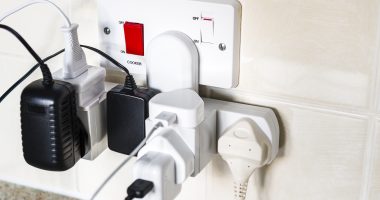

It’s still continuing. We have towers deployed all along the southern border and the northern border. It’s part of Congress’s annual budget. But the vast majority of our work has been on the military side. There’s no billion-dollar contracts coming down the line to massively expand the border work.
When I visited the border with you in early 2018, it was just before we learned about families being separated and other miseries. How do you feel about that?
I’m still really proud of our work that we do with border security. The reality is, no matter what you want immigration policy to be, you should know what’s crossing the border. You’ve seen this with the Biden administration. They’ve changed policy on how to handle people coming across the border, but they still want to know if people are smuggling drugs into the US, weapons out of the US, cash back and forth. No matter what your immigration policy is, very few people want there to be no awareness of it. So I think that’s one of the reasons we’ve continued to do well, even on the border security work with the new administration.
It would seem that the shift from building a wall to monitoring the border helps you.
Yeah. The first deployment that Customs and Border Protection actually paid us for was in an area where there was already a 19-foot steel barrier, but it still wasn’t stopping the traffic.
Your main focus is what you call Lattice, a way to connect many different sensors and technologies for soldiers to see what’s happening on the battlefield in real time. How is it going?
We’re working with every major branch of the US military. We’re doing a lot of work with the UK Ministry of Defense and the Australian military. The nice thing is they all agree that they want their stuff to be interoperable. The goal of Lattice is to fuse all of the sensors and all of the effectors that DOD has, not just the things that we make. I had a recent AVMS [Adaptive Vehicle Monitoring System] exercise, where we fused several dozen different existing systems. We’ve used the system in a naval destroyer and its weapon systems, and we’ve used it in some manned fighter jets. Lattice builds a picture that marks relevant things and then pushes that data to the people that need to know about it in real time.
Autonomous weapons are a controversial subject. Should we be OK with AI-based systems pulling the trigger?
We have that today. I’ve talked to people who say, “We should ban development of autonomous weapon systems before it’s too late,” but they already exist, like the close-in weapon systems that protect our aircraft carriers from incoming missiles. We have cruise missiles that can hit surface-to-air missile sites—those basically fly toward a general area, look for electronic emissions, and then strike it without sending out any comms back home. There’s no other way to solve the problem. You can’t have a person literally be responsible for pulling the trigger in every instance. The issue is to make sure that responsibility for them always lands with a person. You need to design ways of thinking about the deployment of autonomous weapons that ensures that that thinking is happening before the trigger is pulled.






